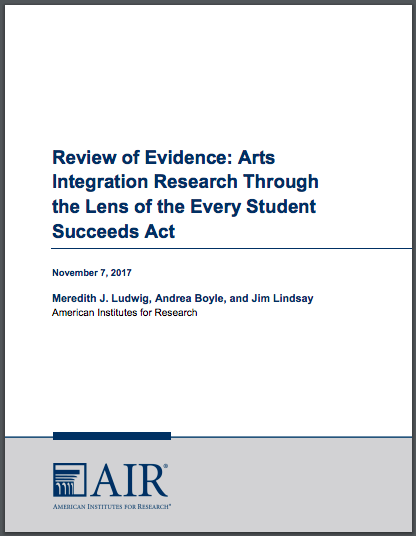 |
A new report from the American Institutes for Research (AIR) and The Wallace Foundation, “Review of Evidence: Arts Integration Research Through the Lens of the Every Student Succeeds Act,” explores the evidence base for arts integration and the ways in which funding from the Every Student Succeeds Act (ESSA) can be used to integrate arts into other academic subjects. While the report mainly explores how ESSA funding can be used to support arts integration during the school day, afterschool programs are included as a promising opportunity for ESSA-funded arts integration.
Linking the arts to other subjects, and using art as a means to teach math, history, language arts, or other traditional subjects, has been associated with positive youth outcomes – especially for students from low-income communities. This report, however, is the first comprehensive look at the evidence base associated with arts integration written with the intent to help stakeholders make the case for funding to support arts integration in and out of school.
This report is especially timely given that many ESSA funding streams require or favor programs that can show evidence-based success. Within ESSA, different funding streams require varying levels of evidence rigor – evaluated by a four-tier system that classifies evidence as “strong,” “moderate,” “promising,” and “under evaluation.”
Evidence base for arts integration
For this study, AIR conducted a literature review of the existing studies on arts integration, and classified the reports that they found within ESSA’s four tiers of evidence. Overall, the review looked to answer two main questions:
- Is there research that shows the positive impact of arts integration programming?
- How large are the effects of arts integration on student outcomes?
To address these questions, AIR conducted a comprehensive search of educational databases and clearinghouses to find reports focused on arts integration, yielding 135 reports or studies with empirical data on student outcomes from Pre-K to 12th grade. While only one of these reports showed “strong,” tier one evidence and the majority of evidence was categorized as “under evaluation,” evidence for arts integration leading to positive student outcomes was found at all of the ESSA evidence tiers.
As part of their study, AIR also conducted a meta-analysis of 27 studies of arts integration programming. The results of this meta-analysis were used to determine the impact of arts integration programs on students, and found a statistically significant, modest impact on student outcomes. Based on this analysis from studies falling within the “strong,” “moderate,” and “promising” evidence tiers, students participating in an arts integration program can expect a four percent increase in achievement as a result of their participation.
ESSA funding for arts integration in afterschool
The report identified 12 different funding opportunities that state educational agencies, local educational agencies, and/or schools can use to support arts integration, including two that can be specifically used for out-of-school time arts integrated learning:
- Title IV, Part B: 21st Century Community Learning Centers
- Title IV, Part F: National Activities Subpart 2 – Community Support for School Success
21st Century Community Learning Centers – a federal funding stream for supporting afterschool and summer programs nationwide – is identified as a way for high-poverty and low-performing schools to institute arts integration programming with ESSA funding.
Community Support for School Success funding is distributed through the Promising Neighborhood and Full-Service Community Schools grants. Promising Neighborhoods grants support neighborhoods with high rates of poverty and low-performing schools, while the Full-Service Community Schools grants are awarded for providing a continuum of support services in elementary or secondary schools. These funding streams can be used for arts integration that focuses on improving academic and social-emotional outcomes. While this funding stream does not focus exclusively on out-of-school time learning, extended learning time opportunities—including before school, afterschool and summer programs— that use arts integration strategies are included as examples of eligible programming.
Recommendations
The report concludes with two overarching recommendations; the first, to practitioners and policymakers, encourages thorough examination of arts integration efforts when allocating funding to ensure programs are implementing best practices for student success. The second recommendation calls for more research to identify the impact of, and best practices for, quality arts integration programs. Ultimately, the more evidence that is collected on the successes and impacts of these programs, the easier it will become to direct ESSA funding to arts integration, both in and out of school.
Currently, out-of-school time remains one of the most opportune spaces for integrating the arts. According to America After 3PM, nearly two-thirds of parents of children in an afterschool program report that their program offers opportunities for music and art, but the demand for afterschool far outpaces the supply of programs. Under ESSA, both 21st Century Community Learning Centers and Community Support for School Success specifically allow funding to be directed to out-of-school experiences and this new report will help more programs make the case for directing funding to arts integration in afterschool and summer programs.
For more information on how ESSA can be used to fund arts integration efforts, and sources of evidence to support arts integration implementation, read the full report!
Comments are closed.